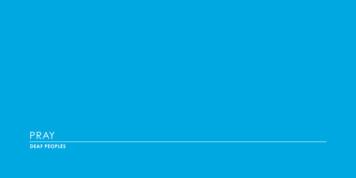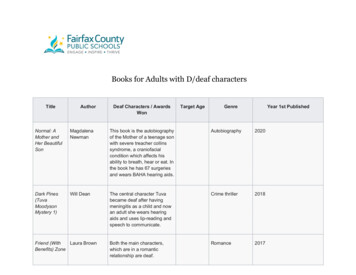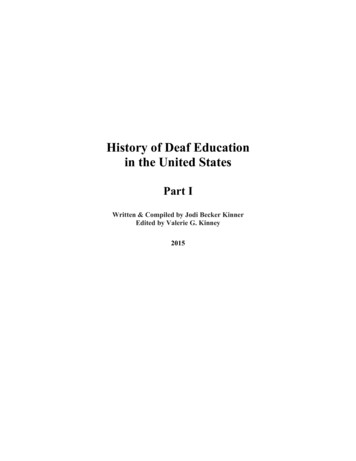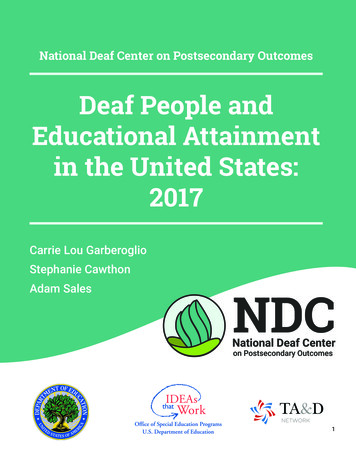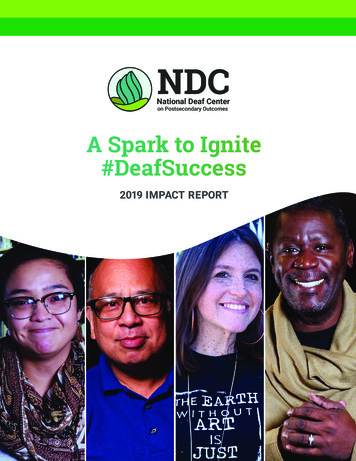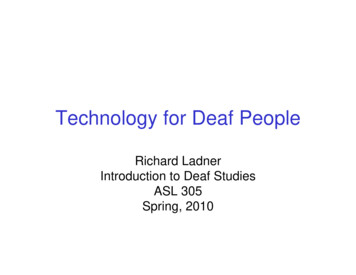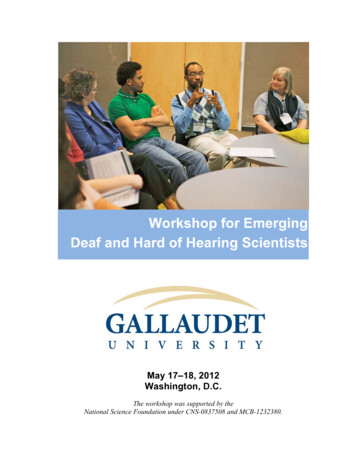
Transcription
!Workshop for EmergingDeaf and Hard of Hearing ScientistsMay 17–18, 2012Washington, D.C.The workshop was supported by theNational Science Foundation under CNS-0837508 and MCB-1232380.
Workshop forEmerging Deaf and Hard of Hearing ScientistsPlanning CommitteeCaroline M. Solomon (Chair)ProfessorDepartment of Science, Technology, and MathematicsGallaudet UniversityBiological oceanographyDerek BraunProfessorDepartment of Science, Technology, and MathematicsGallaudet UniversityGeneticsRaja KushalnagarAssistant ProfessorDepartment of Information and Computing SciencesRochester Institute of TechnologyInformation TechnologyRichard E. LadnerProfessorDepartment of Computer Science & EngineeringUniversity of WashingtonComputer ScienceDaniel LundbergAssistant ProfessorDepartment of Science, Technology, and MathematicsGallaudet UniversityChemistryRonald PainterLecturerDepartment of Chemistry and BiochemistrySan Francisco State UniversityChemistryRegina NuzzoAssociate ProfessorDepartment of Science, Technology, and MathematicsGallaudet UniversityStatistics
Table of ContentsChapter 1: Introduction .1Chapter 2: Experiences of Students in STEM .13Chapter 3: Inclusion of Deaf and Hard of Hearing Students in Summer ResearchPrograms .21Chapter 4: Experiences of Deaf and Hard of Hearing Professionals .31Chapter 5: Technical Resources Available for STEM Students .43Chapter 6: Interpreting in STEM .53Chapter 7: Where Do We Go From Here? .59
Chapter 1: IntroductionCaroline Solomon, Ph.D., professor, Department of Science, Technology, and Mathematics,Gallaudet UniversityAims of the workshopDeaf and hard of hearing individuals are a greatly underutilized national resource thatcould make tremendous future contributions to science if given the chance. Historicalresearch has revealed that deaf and hard of hearing individuals have made significantcontributions to the field. For example, deaf astronomer Anne Jump Cannon (1863–1941)catalogued many stars and was awarded the Henry Draper Medal from the NationalAcademy of Sciences in 1931. The co-developer of the Internet, Vinton Cerf (1943–), alsodeaf, received the Turing Award and was inducted into the National Academy of Engineers.Deaf and hard of hearing persons have discovered chemical elements, biological principles,stars and comets, and patented hundreds of inventions (Lang 1994; Lang and Meath-Lang1995). Yet, the proportion of deaf and hard of hearing people in science, technology,engineering, and mathematics (STEM) is very small (0.13–0.19%) compared to that of thegeneral population (11–15.3%; NCSES 1996, 2004, 2009, 2011b). Supporting the educationof the next generation of young deaf and hard of hearing scientists, then, is crucial and willcertainly enhance both the field and society in general.To explore how we can increase the successful participation of deaf and hard-ofhearing professionals in STEM, Gallaudet University hosted a two-day mentoring andnetworking event, Workshop for Emerging Deaf and Hard of Hearing efault.aspx?EventID 1044760), May 17–18, 2012,to discuss common barriers, challenges, and solutions to pursuing degrees or careers invarious STEM disciplines. The 97 workshop participants included high school, college, andgraduate students as well as K–12 educators, sign language interpreters, universityprofessors, and government employees.The workshop focused on the importance of vertical mentoring, also known ascascade mentoring, which has been successful for women in STEM (Packard 2003; Packardand Nguyen 2003; Larios 2005; Fang and Van Vliet 2006; Yen et al. 2007). In addition tovertical mentoring, network mentoring—that is, mentoring among different people atdifferent levels—can be successful as opposed to traditional one-on-one mentoring (Yen etal. 2007). A study of mentoring minorities revealed that a successful mentor can differ fromthe mentee in terms of gender, field of study, ethnic background, socioeconomic status, ordisability status, but mentees prefer a mentor who closely resembles them demographically(Frierson et al. 1994). This workshop laid the foundation for network mentoring amongparticipants, recognizing that having more than one mentor in the field can benefit deaf orhard of hearing STEM students. The workshop allowed participants to establish mentorrelationships with others in STEM who are deaf or hard of hearing and also those who havehad similar experiences or challenges due to shared educational backgrounds orcommunication preferences.Workshop for Emerging Deaf and Hard of Hearing Scientists (White Paper)Chapter 1: Introduction1
Underrepresentation of deaf and hard of hearing professionals in STEMSTEM degrees among deaf and hard of hearing students. According to the reportDoctorate Recipients from U.S. Universities (NCSES 2011a), 237 deaf and hard of hearingpeople earned doctorates in diverse fields including non-STEM disciplines in 2010. Of thosedoctorates, 21% were in life sciences, which includes agricultural and natural sciences,biological and biomedical sciences, and health sciences; 13% were in physical sciences,which includes chemistry, mathematics, and computer science; and 6% were in engineering.These numbers are substantially lower than those of the general population, where 36%earned doctorates in the life sciences, 26% in physical sciences, and 16% in engineering(NCSES 2011a).During the years 2006–Table 1. Number of deaf and hard of hearing doctorates2010, 301 deaf and hard ofearned in different STEM fields from 2006-2010hearing people earned doctoralNumber reportingdegrees in specific STEM fieldsdeaf/hard of hearingMajor field of study(Table 1). Some sub-disciplinesAgricultural sciences/natural resources14were not reported because fewerBiological/biomedical sciences71than 4 people earned degrees inChemistry13those fields, such as astronomy,Computer and information sciences17Engineering43and geological and earthHealthsciences51sciences. The highest percentageMathematics13of people earning degrees was inOcean/marine sciences5the biological and biomedicalPhysics9sciences (24%) with the lowestPsychology65percentage found in ocean andTotal301marine sciences (1.7%).Note. Counts include individuals reporting one or more otherThe rate of STEM majors functional limitations in addition to deaf/hard of hearing. Data fromamong deaf and hard of hearingSurvey of Earned Doctorates, special tabulation (July 2012).undergraduates, however, iscomparable to that of the general population (Table 2). At four-year colleges, 17.0% of deafand hard of hearing students major in math, computer science, engineering, and technologyas opposed to 18.2% of the general population. The percentage of deaf and hard of hearingstudents majoring in STEM fields at 2-year colleges exceeds that of the general populationwith 13.2% compared to 9.7%. However, many of these students do not obtain doctorates(0.13–0.19% v. 11.0–15.3%; NCSES 1996, 2004, 2009, 2011b), reflecting substantial loss ofdeaf and hard of hearing students between the undergraduate and postgraduate school years.2Workshop for Emerging Deaf and Hard of Hearing Scientists (White Paper)Chapter 1: Introduction
Table 2. Percentage of hearing and deaf and hard of hearing students in STEM and non-STEMmajors by level of education (Walter 2010)4 yearHearingDeaf/HHN 9,427,100 N 56,5002 yearHearingDeaf/HHN 7,633,800 N 70,100 2 yearHearingDeaf/HHN 479,900N s18.2%17.0%9.7%13.2%6.0%6.2%Social/behavioral 2%86.5%86.5%Non-STEM fieldUndeclared or not in a7.3%10.0%22.0%13.5%7.5%degree programSource: U.S. Department of Education, National Center for Education Statistics, 2007–08 NationalPostsecondary Student Aid Study (NPSAS:08)7.3%Figure 1 details the distribution of deaf and hard of hearing undergraduate students invarious STEM fields, which varies from 30% and 28% in engineering and biological andbiomedical sciences, respectively, to 2% in science technology (Walter 2010).Figure 1. Distribution of STEM disciplines among deaf and hard of hearing undergraduate students(Walter 2010)Demographics of workshop participants. The workshop had 97 participants ofwhich 55% were deaf, 17% were hard of hearing, and 28% were hearing (Figure 2). Of thedeaf and hard of hearing attendees, most preferred to communicate through ASL (77%),Workshop for Emerging Deaf and Hard of Hearing Scientists (White Paper)Chapter 1: Introduction3
while others preferred captioning (13%), Signed English (6%), and cued speech (4%; Figure3). Participants included high school, undergraduate, and graduate students and establishedprofessionals (Figure 4). The STEM fields of the deaf and hard of hearing participants werequite diverse (Figure 5) and included people in psychology, psycholinguistics, veterinarymedicine, biomedical sciences, physical sciences, nanoscale science and engineering, andstatistics. Several high school and beginning college students were uncertain about their areaof interest in STEM. The distribution of STEM fields of attendees at the workshop wassimilar to that found for deaf and hard of hearing doctorates summarized in Table 1.Figure 2. Hearing status of workshop participantsFigure 3. Communication preferences of deafand hard of hearing workshop participantsFigure 4. Educational level or type ofemployment of workshop participantsFigure 5. STEM disciplines of deaf and hard ofhearing workshop participantsA need for a mentoring and networking framework for deaf and hard ofhearing people in STEMPrior to the workshop, we established that a mentoring and networking framework fordeaf and hard of hearing people in STEM was direly needed to support people transitioningfrom high school to college and from undergraduate to graduate school. We need to firstrecruit and retain students in STEM fields for their undergraduate studies, and then find waysto address the serious loss of students from the undergraduate to postgraduate part of theeducational pipeline (a decline from 17.0% to 0.19%; Walter 2010; NCSES 2011b).Student mentoring and networking. Many programs have focused on one stage ofstudents (e.g., high school or college) rather than building a foundation for these students tosuccessfully build a career path. For example, TechGirlz at the National Technical Institute4Workshop for Emerging Deaf and Hard of Hearing Scientists (White Paper)Chapter 1: Introduction
for the Deaf (NTID) and Science Star programs at Gallaudet University focused on middleschool and high school students, respectively. While these efforts help pique interest inSTEM fields, a more systematic approach to maintaining and nurturing interest is necessaryto grow the next generation of deaf and hard of hearing STEM professionals.In order to be successful, a mentoring program for deaf and hard of hearing studentsmust incorporate mentoring throughout all stages of education. As such, universities arebeginning to advocate mentoring among undergraduate and graduate students andpostdoctoral researchers, leading to a unified learning community in research groups(Gonzalez 2001). For postgraduate students, the National Institute on Deafness and OtherCommunication Disorders at the National Institute of Health (NIH) offers a program thatincorporates mentoring through all levels; however, it is limited to those who are in NIH’sresearch areas action plan.aspx).Some recent mentoring efforts have shown promise. One example is the Deaf STEMCommunity Alliance (http://www.rit.edu/ntid/dhhvac/), which hosts an online virtualacademic community for STEM faculty, students, and staff of NTID, Camden CountyCollege, and Cornell University. The primary elements of the virtual academic communityinclude Web-conferencing tools to provide students with remote tutoring, mentoring,interpreting, and captioning services; the establishment of a synchronous/asynchronouscommunication network to create the academic community; and access to electronicresources, such as sign language dictionaries, professional organizations, captioned media,reports, and papers.Besides mentoring, deaf and hard of hearing students perceive networking as acritical resource to maintain their participation in STEM. In June 2008, Rochester Institute ofTechnology (RIT) hosted the Summit to Create a Cyber-Community to Advance Deaf andHard of Hearing Individuals in STEM, which focused on establishing infrastructure thatwould provide access for deaf and hard of hearing students in STEM. The undergraduate andgraduate students in attendance expressed a strong interest in meeting more students throughoutthe country who are majoring in STEM fields in order to exchange experiences and ideas.Professional mentoring and networking. Earlier attempts to establish mentoring ornetworking programs for deaf and hard of hearing STEM professionals have had eitherlimited success or have become inactive. Mentoring efforts occasionally are part of a largerprogram, such as FORWARD to Professorship, which serves many minority groups.However, these efforts do not always address the challenges unique to deaf and hard ofhearing people in the workplace. A deaf-focused networking effort started by Deaf Womenin Science and Engineering (DWSE) provided presentations at various conferences (e.g.,Deaf Women United) but ceased activity. Consequently, the program has been dormant formore than five years.Deaf and hard of hearing scientists in the workforce agree that networking is vital fortheir retention and career development in STEM fields. Networking facilitates discussion oftopics such as (1) obtaining access at conferences and workshops and in the workplace;(2) sharing and building important resources, such as cataloguing technical signs (Lang et al.2007) and increasing the pool of interpreters or real-time captioners knowledgeable of STEMcontent (Seal et al. 2002; MacDonald 2009); and (3) establishing a support system. Currently,an organization of deaf academicians and researchers from various fields exists(www.deafacademics.org), but interactions are limited to email Listserv or Facebook, andWorkshop for Emerging Deaf and Hard of Hearing Scientists (White Paper)Chapter 1: Introduction5
most discussions focus on issues in the social sciences. Few STEM scientists who work forthe government or in private laboratories actively participate in this group. There also havebeen scarce opportunities for deaf and hard of hearing scientists to meet in person to discusschallenges they face in STEM (Table 3). Consequently, the establishment of a formalnetwork of deaf and hard of hearing scientists that includes people in academia, government,and private research laboratories is very much needed.Table 3. Recent networking and educational opportunities at conferences or workshops that focusedon underrepresented groups in STEM (not necessarily just on deaf and hard of hearing people)Conference/Workshop & PurposeLocationDatesSTEM Mentoring for Youth with Disabilities: Research, Practice, andResources — Discuss and review literature about STEM mentoring foryouth with disabilities, girls, and racial/ethnic minorities.WebinarMay 17, 2012Emerging Researchers National (ERN) Conference in STEM — Helpundergraduate and graduate students to enhance their sciencecommunication skills to better understand how to prepare for sciencecareers in a global workforce.Atlanta, GAFebruary 23–25, 2012American Association for the Advancement of Science: Foundationfor Science and Disability — Promote the integration of scientists withdisabilities into all activities of the scientific community and of society as awhole and promote the removal of barriers that hinder success of studentswith disabilities in pursuit of scientific careers.Vancouver,BritishColumbiaFebruary 17,2012(next meetingwill be inFebruary 2013)Association of Medical Professionals with Hearing Losses (AMPHL) —Provide information, promote advocacy and mentorship, and create a networkfor individuals with hearing loss interested in working in health care fields.Portland, ORAugust 6–7,2011FORWARD to Professorship — Provide information, skills developmentmentoring, and networking for a successful bid for a tenure-trackprofessorship in STEM. Deaf and under-represented minorities arestrongly encouraged to participate.Washington,DCMay 23–25,2011Academic Workshop for Underrepresented Ethnic Minorities andPeople with Disabilities — Provide unique, tailored experiences aboutthe academic career ladder for underrepresented ethnic minorities andpeople with disabilities at the assistant- and associate-faculty level andsenior doctoral students.Los Angeles,CAFebruary 24–27, 2011Deaf Academics — Promote interaction and fellowship among deafacademicians around the world.Florianópolis,BrazilNovember21–24, 2010Minority Faculty Development Workshop — Equip tenure-track juniorand mid-level science and engineering faculty with tools and strategies tobetter navigate their careers.Cambridge,MAMarch 21–24,2010A Working Conference Focused on Supporting Students withDisabilities in STEM: A Promising Practice for Changing Attitudes —Provide stakeholders with a forum to combine knowledge, experiences,and perspectives to change attitudes and beliefs about students withdisabilities in STEM.MidwestApril 1–2,2009Summit to Create a Cyber-Community to Advance Deaf and Hard ofHearing Individuals in STEM — Promote and develop a cyberinfrastructure for accessibility for deaf and hard of hearing students in STEM.Rochester,NYJune 25–27,2008CEOSE mini-symposium (National Science Foundation) — Discusshow to encourage full participation of people with disabilities in STEM.Washington,DCOctober 15,20076Workshop for Emerging Deaf and Hard of Hearing Scientists (White Paper)Chapter 1: Introduction
Broadening participation in STEM with a focus on deaf and hard ofhearing peopleFor a long time, the National Science Foundation (NSF) has demonstrated a stronginterest in broadening the participation of underrepresented groups in STEM, which itreiterated in a recent Dear Colleague Letter (NSF 2012) about the goal to prepare, engage,and motivate a diverse STEM workforce. In the past, NSF has funded many grants that focuson deaf and hard of hearing people, including Classroom of the Sea and Clearinghouse onMathematics, Engineering, Technology, and Science (COMETS). The foundation has alsosupported grants that encourage participation in STEM by deaf students, along with otherdisability groups, such as the American Association for the Advancement of Science(AAAS) Entry Point! program.Some well-meaning programs by different organizations, such as Advancing Sciencein Limnology and Oceanography’s (ASLO) Multiculturalism in the Aquatic Sciences (MAS)and Ecological Society of America’s (ESA) Diversity in Ecology, do not target people withdisabilities, especially deaf and hard of hearing people. However, ASLO is supportive of itsdeaf and hard of hearing members and provides access at its conferences. Like ASLO, otherprofessional societies, such as Society of Environmental Toxicology and Chemistry(SETAC), Association of Computing Machinery (ACM), and Association for ChemoreceptionSciences (AChemS), have a good track record of providing access to deaf and hard of hearingparticipants. A comprehensive list of organization and conference guidelines (or links)should be developed to share resources, especially when a professional organization orconference organizers encounter having deaf or hard of hearing participants for the first time.Certain professional societies have proactively included scientists, engineers, andmathematicians with disabilities. ACM has a special interest group on computing educationthat has had deaf attendees for the past four years. The American Chemical Society (ACS)has a long history of promoting educational and professional opportunities for chemists withdisabilities through its Chemists With Disabilities (CWD) committee, on which many deafand hard of hearing chemists have served. ACS has also developed excellent educationalmaterials for teaching students with disabilities.Since 1975, AAAS has coordinated many projects that were funded by NSF,including the AAAS Project on Science, Technology and Disability, which recently publishedits 30 year report (AAAS 2007). The project began when a deaf biochemist, John J. Gavin,wrote a letter to William D. Carey, president of AAAS, suggesting the association addressdisability issues, leading to the watershed symposium in 1975 that framed the future ofAAAS activities. Under the leadership of Virginia Stern, AAAS started many otherinstrumental programs, such as the aforementioned Entry Point! internship program(http://ehrweb.aaas.org/entrypoint/), and significant publications such as Resource Directoryof Handicapped Scientists (later called Resource Directory of Scientists and Engineers withDisabilities). An affiliate of AAAS, Foundation for Science and Disability(http://stemd.org/), was established in 1978 and publishes a newsletter. Many deaf and hardof hearing people have benefitted from these AAAS programs.Professional societies that focus on STEM education have also been supportive ofdeaf and hard of hearing participants at their conferences. The National Science TeachersWorkshop for Emerging Deaf and Hard of Hearing Scientists (White Paper)Chapter 1: Introduction7
Association (NSTA) has provided interpreters at national and regional conferences since themid-1970s, and a subgroup, the Science Association for Persons With Disabilities, wasformed and for many years included newsletters as a form of networking. The Associationfor Science Teacher Education (ASTE) and the National Association for Research in ScienceTeaching (NARST) have included deaf-related articles in their journals. Science educationorganizations also have a long history of supporting deaf students (Lang 1983).Challenges faced by deaf and hard of hearing scientists, engineers, andmathematicians – focus of the white paperThe link between language, cognition, and learning for deaf and hard of hearingpeople studying STEM has been reviewed intensively by Marschark and Hauser (2008).Their work offers insight on why more deaf and hard of hearing people do not enter STEMfields. These researchers targeted the early educational experiences of deaf children and thelack of exposure to science in comparison to hearing peers (Kelly 2008; Marschark andWauters 2008). Among the cognitive issues they discuss are how younger deaf students areless likely to connect inferences and automatically relate concepts over multiple dimensions,which is an instrumental skill in STEM (Marschark and Wauters 2008).The focus of the current white paper is on deaf students who are in their later years ofhigh school education and are ready to pursue STEM degrees, and deaf college andpostgraduate students who are ready to continue their education or gain employment inSTEM. Some challenges mentioned by Marschark and Hauser (2008) are pertinent to thispopulation:1. The division of visual attention during the reception of STEM materials throughspoken language, sign language or real-time text, the instructor, and other visualmaterials such as PowerPoint presentations. This will be discussed further inChapter 5: Technical Resources Availablefor STEM Students.2. The ability to integrate STEM information from classes, textbooks, and otherstudy materials as compared to hearing peers (Richardson et al. 2010)3. The lack of a common sign language lexicon for scientific terms and training forinterpreters in techniques for interpreting STEM lectures and laboratories(Redden et al. 1978; Lang et al. 1983; Lang 2002; Lang et al. 2007). This will bediscussed further in Chapter 5: Technical Resources Available for STEM Studentsand Chapter 6: Interpreting in STEM.During the current project’s workshop, these and other issues surfaced in the deafstudents’ anecdotal accounts. For example, with regard to the issue of multiple visualdemands, one graduate student summarized the challenges and how to overcome them:I face challenges as a deaf person in both my classes and at my workplace,but find ways to work through them. For example it can be challenging duringlabs when I have to look at a sample through a microscope while theinstructor is talking. In situations like this I ask the instructor to first explainand then wait to give students time to find and observe what is being looked atbefore moving on. In the work place, I have several strategies that help meensure I have correct information. The procedures to follow for using specificlab equipment and data-collecting techniques are written down in a binder. In8Workshop for Emerging Deaf and Hard of Hearing Scientists (White Paper)Chapter 1: Introduction
addition to this, I usually repeat back instructions that are new to me or if Iam not sure I completely understand what is going on, I give my colleagues achance to correct me before any mistakes are made.In order to examine the many language, cognition, access, and other challenges ofdeaf and hard of hearing people in STEM, we will present on the following pages theexperiences of deaf students (Chapter 2) and deaf professionals (Chapter 4) in order toidentify effective mentor strategies and reduce attrition from undergraduate and graduateprograms. We will also discuss the principles and practices for involving deaf and hard ofhearing students in undergraduate research programs (Chapter 3) with better tools andservices (Chapters 5 and 6).This material is based on work supported by the National Science Foundation under CNS0837508 and MCB-1232380.References[AAAS] American Association for the Advancement of Science. 2007. Thirty years ofchanging lives: The AAAS project on science, technology, and disability [Internet].Washington (DC): AAAS. Available 2/08/30-Years-of-Changing-Lives.pdf.Fang Z, Van Vliet, EM. 2006. Work in progress: A unique self-supporting program forwoman engineering students at a Christian university. In: Proceedings of the 36thAnnual Frontiers in Education Conference [Internet]; 2006 Oct 28-31; San Diego,CA. Piscataway (NJ): Institute of Electrical and Electronics Engineers. p. 27-28.Available from: on HT, Hargrove BK, Lewis NR. 1994. Black summer research students’ perceptionsrelated to research mentors’ race and gender. J Coll Student Dev. 35(6):475-480.Gonzalez C. 2001. Undergraduate research, graduate mentoring, and the university’smission. Science. 293(5535):1624-1626. Available from:doi:10.1126/science.1062714.Kelly RR. 2008. Deaf learners and mathematical problem solving. In: Marschark M, HauserPC, editors. Deaf cognition: Foundations and outcomes. New York (NY): OxfordUniversity Press. p. 226-249.Lang HG. 1983. Preparing science teachers to deal with handicapped students. Sci Educ.67(4):541-547. Available from: doi:10.1002/sce.3730670409.Lang HG. 1994. Silence of the spheres: The deaf experience in the history of science.Westport (CT): Bergin & Garvey.Lang HG. 2002. Higher education for deaf students: Research priorities in the newmillennium. J Deaf Stud Deaf Edu. 7(4):267-280. Available from:doi:10.1093/deafed/7.4.267.Lang HG, Hupper ML, Monte DA, Brown SW, Babb I, Scheifele PM. 2007. A study oftechnical signs in science: Implications for lexical database development. J Deaf StudDeaf Edu. 12(1):65-79. Available from: doi:10.1093/deafed/enl018.Workshop for Emerging Deaf and Hard of Hearing Scientists (White Paper)Chapter 1: Introduction9
Lang HG, Meath-Lang B. 1995. Deaf persons in the arts and sciences: A biographicaldictionary. Westport (CT): Greenwood Press.Lang HG, Sachs MC, Egelston-Dodd J. 1983. Science education for hearing-impairedstudents in the eighties: Priorities and projections. Am Ann Deaf. 128(8):801-808.Larios M. 2005. Research and collaboration: Global narratives for success. In: Morrell C,Sanders J, editors. Proceedings of the International Symposium on Women and ICT:Creating Global Transformation [Internet]; 2005 Jun 12-14; Baltimore, MD. NewYork (NY): ACM. p. 20. Available cDonald G. 2009. Integrating interpreting, hearing and deaf students in summer research.In: Boyd ML, Wesemann JL, editors. Broadening participation in undergraduateresearch: Fostering excellence and enhancing the impact. Washington (DC): Councilon Undergraduate Research. p. 199-210.Marschark M, Hauser PC. 2008. Cognitive underpinnings of learning by deaf and hard ofhearing students: Differences, diversity, and directions. In: Marschark M, Hauser PC,editors. Deaf cognition: Foundations and outcomes. New York (NY): OxfordUniversity Press. p. 3-23.Marschark M, Wauters L. 2008. Language comprehension and learning by deaf students. In:Marschark M, Hauser PC, editors. Deaf cognition: Foundations and outcomes. NewYork (NY): Oxford University Press. p. 309-350.[NCSES] National Center for Science and Engineering Statistics (US). 1996. Women,minorities and persons with disabilities in science and engineering: 1996. Data ReportSeries. Arlington (VA): National Science Foundation (US). NSF Pub. No. 96-311.Available from: [NCSES] National Center for Science and Engineering Statistics (US). 2004. Women,minor
Rochester Institute of Technology Information Technology Richard E. Ladner Professor . The 97 workshop participants included high school, college, and graduate students as well as K-12 educators, sign language interpreters, university . quite diverse (Figure 5) and included people in psychology, psycholinguistics, veterinary medicine .




